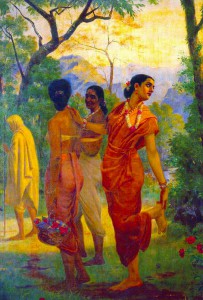
Object Label
Shakuntala looks back at Dushyanta
Kilimanoor(India)
1898, Oil on canvas
This painting constructs a romantic and desirable feminine image of Shakuntala as she is seen looking back at her lover, Dushyanta while pretending to remove a thorn from her feet. Shakuntala is an important character in the Mahabharata, a love story in one of the two great Hindu epics. She is the child of Vishwamitra, one of the most respected sages in ancient India and the Apsara Menaka, one of the most beautiful supernatural female beings.
The King of the Devas, Indra was frightened by Vishwamitra’s power and sent Menaka from heaven to earth to distract him from his deep meditation. She succeeded in luring him and eventually bore a child by him. However, when he realized that Indra has tricked him, he was enraged and cursed Menaka to be separated from him. She had to leave for the heavenly realms and placed the newborn Shakuntala in the forest. Kanva, a renowned rishi of the Treta yuga, found the newborn child surrounded by Shakunta birds in the forest and raised her as his daughter whom he named her as Shakuntala.
One day, King Dushyanta was out on a hunting expedition in forest with his army when he first encountered Shakuntala at Kanva’s ashram. They fell in love with each other and got married. However, he needed to leave for his kingdom and offered his royal ring to her as a token of his love where he promised to come back to take her with him. Soon after he left, she gave birth to a son named Bharata. She spent most of the time dreaming of her husband and was often distracted by it. One day, a powerful rishi named Durvasa visited to her house but she failed to greet him properly as she was lost in thoughts of Dushyanta. Enraged by this scene, Durvasa cursed Shakuntala that Dushyanta would only remember her if she show him the royal ring that he gave as a token.
Time passed and Dushyanta failed to return to her. Shakuntala decided to visit him at his kingdom and set out for the capital city with her foster father. However, she lost the royal ring during the journey, which caused Dushyanta not being able to recognize her when she arrived at the court. Faced with humiliation and disappointment, she returned to the forest and took her son to settle in a wild part of the forest. Being surrounded by only wild animals, Bharata grew to be a strong youth.
One day, the royal ring was found and given back to Dushyanta where memories of Shakuntala came back to him. He went to Kanva‘s ashram only to find out that she was no longer there. He began to search deeper into the forest where he discovered Bharata opening the mouth of a lion to count its teeth. He approached the boy who then took him to his mother and the family reunited.
This painting is based on a scene from Kalidasa’s play – The Recognition of Shakuntala, where it is considered to be the best work of the classic Sanskrit writer who dramatized the story of Shakuntala in the epic Mahabharata.
The Influence of the British Empire on Indian Art
The Modern Indian Art Movement in Indian painting begun in the late 19th century where the old traditional paintings were disregarded and gave rise to the establishment of British art schools that propagated western values in art education. This caused a drastic change in the concept of art in India, as there was a difference between teaching practices of British and India. The westerners put emphasize on knowledge and science instead of religion and culture, which made art from a craft tradition to a technical skill that could be acquired easily.
This led to the change of Indian paintings in terms of medium (oil painting) and the perception of art (style, scale and subject matter). Indian painters adopted western conventions and perspectives with an attempt to copy European pictures and portraits. One of the leading academic painters that applied the fusion of Indian traditions with the western techniques was Raja Ravi Varma Coil Thampuran. He was a self-taught Indian painter from the princely state of Travancore whom had managed to learn art from Theodor Jenson; a Dutch portraitist that made Varma mastered the usage of canvas and oil colors, which resulted his style to be of European aesthetic ideals. The combination between the East and the West, the tradition and the modern, led to a creation of a new genre of mythological oil painting where Hindu mythological subject matters are painted in a naturalistic and realistic way instead of stylized and unnatural way yet at the same time, preserve the Indian’s traditional theme.
The themes of Varma’s paintings always encompass around the Indians as he had a desire to develop an internationally respected art style for Travancore. He is noted for his paintings of stories of Dushyanta and Shakuntala and Nala and Damayanti, characters that belong to the Hindu mythology.
Bibliography
Anil Relia, Dr Ratan Parimoo (2014, Nov 18). The Indian Portrait – 5: Colonial influence on Raja Ravi Varma and his Contemporaries
The Metropolitan Museum of Art. The Rise of Modernity in South Asia
Tapati Guha Thakurta (1991, Oct 26). Women as ‘Calendar Art’ Icons: Emergence of Pictorial Stereotype in Colonial India
Wikimedia Commons (Image of Painting)
